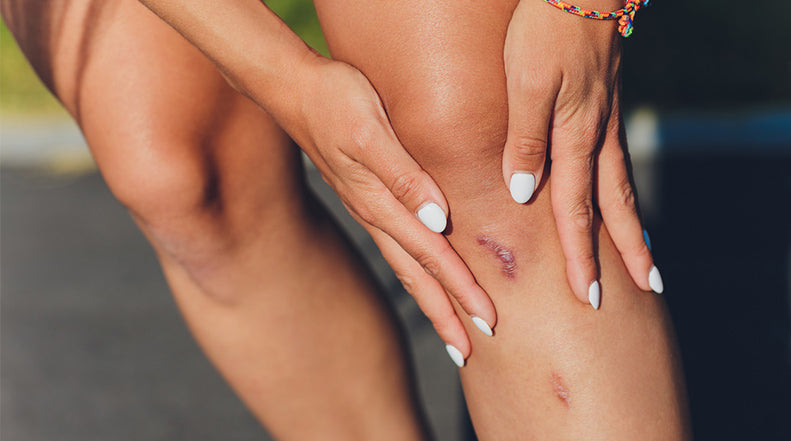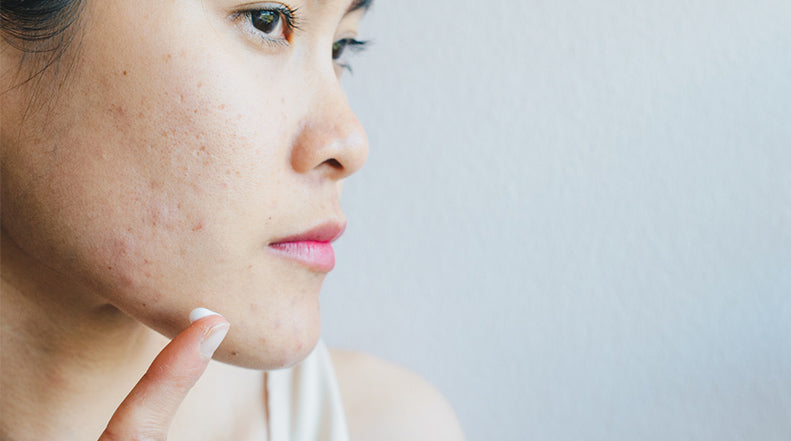What's the Difference Between a Keloid and Hypertrophic Scar?

Do you have a raised, discolored scar that shows no sign of going away anytime soon? If so, you may have a keloid or a hypertrophic scar. Both of these types of scars have a red, dark appearance, they are raised above the skin, and they can sometimes feel lumpy. Also, both keloids and hypertrophic scars are formed due to excess collagen production during the wound healing process. Collagen is a structural protein that gives your skin firmness, strength, and durability. Even though collagen is necessary for a wound to heal properly, too much collagen can lead to a raised, abnormal scar.
While these two types of scars share similar characteristics, there are several differences between them. Keep reading to learn everything you need to know about the difference between a keloid and a hypertrophic scar, as well as the most effective way to treat both!
KELOID SCARS
The main difference between a keloid and a hypertrophic scar is its growth beyond the boundaries of the original site of skin injury. For example, if you’ve ever had an ear piercing you may have experienced a growth of skin attached to the piercing site. It may look and feel like a small ball of skin. This is most likely a keloid. The earlobe is a common site for keloid growth following piercing. You can tell that it is a keloid because the size is much bigger in relation to the small injury caused by the piercing.
Besides the earlobe, areas of the body that have increased susceptibility to keloid formation include the sternum, the deltoid region of the upper arm, and the upper back. It is thought that these areas are associated with keloid formation due to the higher levels of muscle and skin tension. Ethnicities with darker skin pigmentation, such as African Americans and Hispanics, are more prone to keloid formation. Keloids are also frequently associated with negative wound healing factors, such as infection, excessive tension, foreign bodies, and repetitive trauma. However, keloids may form in simple clean wounds. It’s clear that the exact cause for keloid formation is not fully understood.
Keloid scars may turn from red to brown and often have a lumpy appearance. Also, keloid scars are known to cause sensitivity and other uncomfortable sensations. According to AARP, keloid scars may be itchy and cause you to experience discomfort, tenderness, or possibly irritation from your clothing or other forms of friction.
So keloids sound pretty bad, right? Unfortunately, there’s more: if keloid scars are left untreated they can continue to thicken and grow indefinitely! This is another difference between a keloid and a hypertrophic scar, as hypertrophic scars do not continue to grow once they reach a certain point. In order to prevent keloid formation, we recommend using a high-quality silicone gel product for your scar, such as the wide variety of scar treatment products offered by NewGel+.
HYPERTROPHIC SCARS
Hypertrophic scars are also raised, but they are rarely elevated more than 4 mm above the skin. They may be red or pink in appearance. The most important difference between a keloid and a hypertrophic scar is that hypertrophic scars do not grow past the original boundaries of the skin injury. Similar to keloids, hypertrophic scars are associated with adverse wound healing factors. Additionally, children and those with fair complexions and/or rosacea are especially prone to hypertrophic scarring.
While there is a chance that hypertrophic scars can go away on their own, it is best to treat this kind of scar to promote a faster and better recovery. One of the best treatment options for hypertrophic scars is silicone gel, which you’ll find in all of the NewGel+ scar treatment products.
HOW NEWGEL+ PRODUCTS CAN HELP
NewGel+ is a line of scar treatment products that can help scars of any shape and size, even keloids and hypertrophic scars. All NewGel+ products are formulated with 100% medical grade silicone gel, the gold standard ingredient of topical scar treatment products. In fact, silicone gel is the top recommendation of physicians, surgeons, and scar management experts.
Silicone gel works to heal scars by providing the area with a combination of occlusion and hydration. This helps to prevent the wound from becoming dehydrated. Dehydration can lead to many negative outcomes, such as an increased production of collagen. As mentioned above, excess collagen can lead to the formation of keloids and hypertrophic scarring. Therefore, silicone gel can help to prevent these abnormal types of scars while making your scar softer, flatter, and less noticeable.




Comments